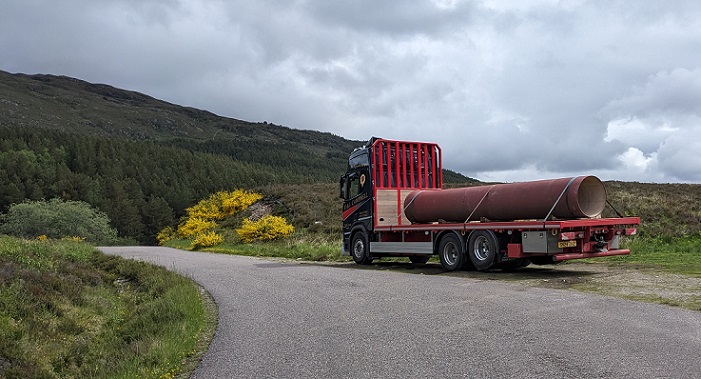
Last Monday, I walked back down Glen Affric from Allt Beithe Youth Hostel and then over to Loch Mullardoch. On the short stretch of public road between the car park and the turn north into Gleann nam Fiadh we passed this lorry with a large metal section of pipe. I guessed at once why it was there, a section of pipeline on the Abhainn Gleann nam Fiadh hydro scheme, which had been granted planning consent in December 2013 and which I had passed during construction in April 2017, must have burst.
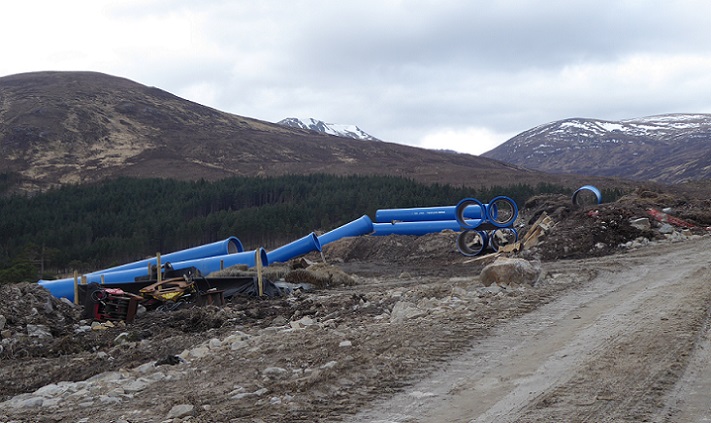
When we reached the road junction with the Gleann nam Fiadh hydro track a digger was being unloaded from the back of a large lorry. The skill of the driver who transported it up the single track road from Cannich was considerable. I stopped to comment on this to the workers who confirmed that a section of the high pressure pipe had indeed burst and what was more, this was not an uncommon occurrence.
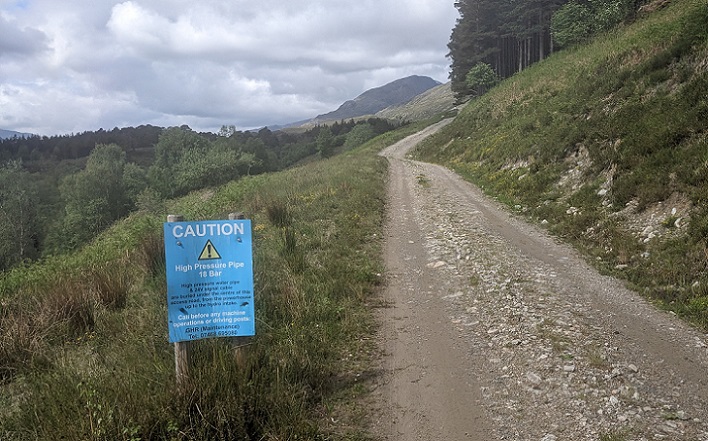 During our discussion it emerged that some of the workers were now working almost full-time on fixing broken run of river hydro schemes across the Highlands. This fitted with what I had seen in Glen Falloch in the Loch Lomond and Trossachs National Park four to five years ago: poorly designed and constructed run of river hydro intakes leaking or filling up with debris making them unusable (see here); and the littering of the countryside with sections of spare pipe, retrospectively justified on the grounds they were needed for repair purposes (see here):
During our discussion it emerged that some of the workers were now working almost full-time on fixing broken run of river hydro schemes across the Highlands. This fitted with what I had seen in Glen Falloch in the Loch Lomond and Trossachs National Park four to five years ago: poorly designed and constructed run of river hydro intakes leaking or filling up with debris making them unusable (see here); and the littering of the countryside with sections of spare pipe, retrospectively justified on the grounds they were needed for repair purposes (see here):
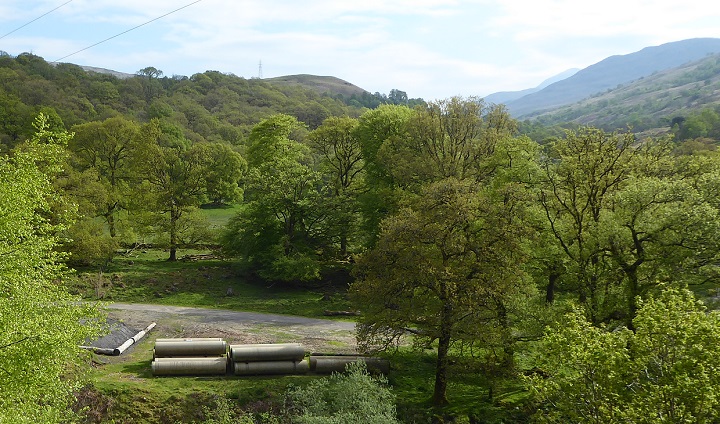
After I complained about the Allt Fionn spare pipes, the Loch Lomond and Trossachs National Park Authority (LLTNPA) asked Glen Falloch Estate to submit a planning application (see here) to turn this spot, next to the Loch Lomond Woods Special Area of Conservation, into a permanent laydown storage area. The justification for the application, which was approved in February 2020, was that:
“Since the construction of the scheme there have been two pipe bursts which have resulted in the necessity to replace a standard section of pipe each time. As such, a retrospective application to retain the laydown area for storage of spare pipe sections has been submitted”.
Its worth emphasising, that is two sections of hydro pipe – in this case fabricated from fibre glass – had burst in just seven years. Judging by the number of pipes in the laydown area both the LLTNPA and the estate expect a lot more! Each time that happens the run of river hydro ceases to produce electricity while the carbon emissions associated with its construction and maintenance increases.
One would not know about any of these carbon or financial costs from the British Hydropower Association Guide to mini-hydro developments, updated in April 2024 (see here):
“Section 6.2.4 Maintenance and Servicing:
“Modern, automated equipment, requires very little maintenance. The cost of routine inspections and an annual service should come to no more than 0.5 to 1% of the capital costs of the scheme. As the machinery ages, there will eventually be extra costs associated with replacing seals and bearings, a new generator, refurbished sluice gates, etc., but these should not occur for at least 10 years”
How then does the British Hydropower Association account for all these burst pipes?
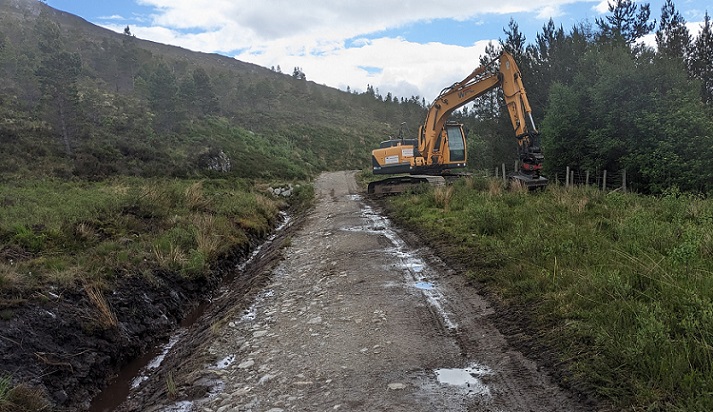
The workers we had spoken to had told us locating a burst hydro pipe is not always simple as they are sometimes several foot underground and the escaping water may flow a significant distance before emerging on the surface. They also said enough for us to gather that during the run of river hydro gold rush there were many failures in both the design of these schemes and the quality of their construction. This burst pipe should never have happened.
The lesson is that if planning authorities, including the Scottish Government’s Energy Consents Unit (which approved the Glen Falloch Schemes), had paid more attention to the location, design and construction of these schemes, not only could they have reduced the carbon costs involved in their construction – as I argued in my last post (see here) – they could also have reduced the carbon costs involved in their maintenance. Maintaining these hydro schemes certainly appears a lot more carbon intensive and expensive than implied by vested interests in the industry.
After returning from Glen Affric, I tried to find just how many run of river hydro failures there have been in Scotland. I have been unable to find any media coverage of the issue – any examples would be welcome! – let alone any research about the extent of the problem.
There are now, however, several businesses providing specialist hydro repairs services e.g. Blue Energy Ltd, Wyvis Power and Plant Ltd (who were undertaking the repairs at the Abhainn nam Fiadh Scheme) and Green Highland Renewables. The latter fulfilled the roles of Project Manager, Principal Design and Site Supervisor roles in the original construction on the Abhainn nam Fiadh, according to the Construction Method Statement on Highland Council planning portal, and has now set up an operations and maintenance hub “to drive the next stage of growth” (see here). Perhaps landowners never asked for guarantees for work undertaken because they had been led to believe hydro schemes were fail safe and required almost no maintenance?
What should now be clear is that the level of skilled maintenance required for run of river hydro is not nearly as low as has been commonly suggested by the industry, on top of which much less skilled maintenance work – such as the excavation of hydro intakes when they fill with debris and sediment – may be undertaken by local estate staff. All this work consumes fossil fuels.
By contrast to this lack of information on modern hydro failures I was interested to discover an example of a pipeline in Canada that had been made out of wood and lasted for c70 years (see here) and a blog post on the replacement of the penstock at the Blackwater dam which dated from the 1930s (see here). It appears that old hydro scheme infrastructure lasted a lot longer than it does now and was therefore by implication much “greener”.
If they want to prevent the climate heating further, there is every reason for Scottish Ministers and planning authorities to start asking why some modern hydro pipes, fabricated from much stronger materials but at the cost of far higher carbon emissions, have only lasted a tenth of the time of older schemes?
In economic terms at least these hydro failures are having some community benefit. Instead of most of the money generated by these schemes ending up in the pockets of wealthy landowners or the city, some is now trickling down into job opportunities in the Highlands. Whether these should be classed as green jobs, however, is another matter.
If we are serious about tackling climate change, instead of treating renewable energy developments as just another opportunity for business interests, government needs to start ensuring that all are constructed to standards that minimise carbon emissions, both those involved in their construction and in their maintenance. That means the Scottish Government taking far more interest than it has up until now in the lifetime carbon emissions of these schemes and their alleged benefits.
Our National Park Authorities could be taking a lead on this given their stated commitment and targets for achieving “net zero”. Their planners should, for example, hold some information on the extent of scheme breakdowns that would assist in calculating the true lifetime carbon costs of these and similar developments. That would in turn enable consideration of whether there were better options for addressing climate change than trashing many of Scotland’s finest glens at public expense for very little electricity.

Very interesting to read about the old wooden penstock in Canada and the Blackwater works much closer to home. How many of the contractors involved in the recent RoR splurge will be able to wax lyrical on their websites in future about quality and durability? Glenfield, whose connection with Blackwater stretches back over a century, certainly can. They were recently called upon to replace some worn out valves, which they duly did despite the complexity of the work. As they say on their website: “This case study, without refute, demonstrates the extensive durability and life service of the original Glenfield valves manufactured and supplied over 100 years ago. It is testament to the Glenfield & Kennedy designers and employees at that time. The craftsmanship and quality of the products produced have ensured many years of successful operation and, with the level of quality and workmanship that Glenfield and the AVK Group continue to offer today, there is no reason why these valves should not provide a further 100 years of operation.” Operating in a different league, I think.
There were a great many hydro schemes constructed for large land holdings in the first decade of the 20th century. Many larger Scottish houses situated far from any opportunity to connect to power generated elsewhere had them installed.
Today most of these early schemes no longer function. When the grid distribution arrived,costly annual maintenance repairs were discontinued. But it is worth noting that a great number of these older catchment sites could have been restored, had the funding been provided to land holders. Modern equipment might have been provided, rather than setting out new projects to trash so many more glens.
In west Lochaber over the past decade I estimate approx 20 new RofR projects with access road systems have been constructed within the 50 mile radius west of Fort William. This is a region in which a great number of early110 volt DC systems became abandoned, some dismantled for scrap. Foundations can still be found left to decay.
These had used heavy rigid cast iron pipe for the penstock, carried up hill using horses and winch tackles ! The turbines ..and generators brought in by sea ..were usually fed through the damming of outlets from hill lochans.
As ground eroded some of these iron pipes later became exposed to frosts; ground-heave caused fractures. Only two local early 20th century schemes I know of, near Acharacle, have been recently enlarged. This was achieved approx 15 years ago now by adding significantly to the height of the remote hillside Lochan catchment dams. The penstock was renewed and reburied. Modern composite pipes and new turbines have resulted in a doubling of annual output, and no new area construction mess. As for ancient engineering being more resilient: the 110 volt DC generating systems installed in the early 20th century on Rum and Eigg….where the national grid never offered an alternative …still exist. Now with modern automated valve control systems and new invertors capable of delivering 240 volts both are said to function well.
Hi Tom, I should have thought about this before – I walked down past one such abandoned scheme about a km south of Castle Tioram, off Loch Moidart, last year
Thanks Nick , Certainly an interesting walk down..steep going up ! . The hydro scheme was built for Dorlin house. It still functioned serving the Sheil foot community until the house itself was blown up in 1964 , after being rendered essentially derelict during wartime requisition.
(topical this 80th anniversary and remembrance week: For those who did not know…This secret place was once HMS Dorlin.Many of the RN ‘commando’ beachmasters for operation Neptune….part of Overlord .. received their very arduous training on local beaches.)